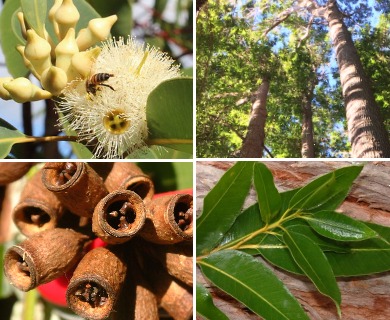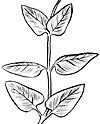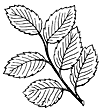Robust Eucalyptus
Eucalyptus robusta
Eucalyptus-Like family (Myrtaceae)
Post-Cook introduction
The most commonly planted tree species and most common eucalypt in Hawaii. Recognized by the thick, soft reddish brown bark, the relatively broad lance-shaped leaves 1 1⁄4–2 1⁄2 inches (3–6 ) wide, the large flowers about 1 1⁄4 inches (3 ) across, the many spreading and the large bell-shaped seed capsules. A moderately large tree 80–160 ft (24–48 ) high. Trunk relatively large, 3-4 ft (0.9–1.2 ) in diameter, straight and one-half to two-thirds the height of the tree. relatively dense, narrow to spreading, with long branches. Bark reddish brown in wet sites, grayish brown where dry, very thick, deeply furrowed into long scaly ridges, fibrous and very soft, Inner bark whitish, fibrous, slightly bitter. Twigs stout, angled, yellowish green, becoming reddish brown.

J. B. Friday
Seed capsules stalked, bell-shaped or cylindrical, 1⁄2– 3⁄4 inch (13-19 ) long and 3⁄8–1⁄2 inch (10–13 ) wide, with flattened or sunken and 3–4 short-pointed valves not protruding.
Because robusta eucalyptus is Hawaii’s most plentiful exotic timber species, its wood properties have been studied intensively. Sapwood is pale brown and heartwood reddish brown, pale when fresh and darkening to a rich mahogany color on exposure. Grain is interlocked and produces a ribbon figure on quarter-sawn faces. Texture is coarse. Moderately heavy ( gr. 0.6) but quite variable in density, as in other eucalypts. Wood from the interior of logs is often lightweight ( gr. 0.35), while that near the log surface may be heavy ( gr. 0.8). The wood compares with white oak (Quercus alba L) in most strength properties but is unstable and shrinks and swells markedly with humidity changes.
It is a difficult and expensive wood to process in sawmilling, as are most eucalypts, because of a peculiarity called growth stress. Growth stresses are longitudinal forces in logs that cause log ends to split open, interior wood near the pith to be crushed into the brittle heart with numerous compression failures, and logs and boards to spring, crook, split, and jam when being sawed. Robusta eucalyptus and saligna eucalyptus grown in Hawaii have severe growth stress.
The wood can be seasoned with little degrade if done with care. It is resistant to decay and termites, more so than western redcedar, but less so than redwood. About 1 million board feet of lumber have been produced each year in Hawaii (none currently) and the wood has been used for many purposes including house siding, framing, and flooring. It has been used in furniture mostly for upholstered frames but is attractive as finish as well. It has performed well as boat framing and conveyor slats used in sugar mills. It has also been used extensively in pallets and irrigation canal stakes. It has also been chipped and sent to Japan for kraft pulp manufacture.
Robusta eucalyptus is the most commonly planted tree in Hawaii. Although it is not currently planted, having been replaced by E. saligna as the preferred species, it has a demonstrated ability to thrive on almost any site with a 500–3500 ft (152–1067 ) altitude that has more than 40 inches (1016 ) rainfall. The Division of Forestry planted more than 2.3 million trees before 1960, and nearly equal numbers were planted by private landowners. On the islands of Hawaii and Maui, there are more than 150 million board feet of sawtimber. The trees may be seen in many places, such as along the road to Koloa, Kauai. The stand near the Nuuanu Pali, Oahu, was planted about 1900. The 1300-acre (526-ha) stand at Opana, Maui, is said to be the world’s largest single block of robusta eucalyptus. There are stands along the highways near Honokaa, Hawaii, and the nearby windbreaks from Mud Lane to Waimea. Recorded from Niihau.
Apparently, this is the best adapted of more than 30 species of Eucalyptus that have been tested for forestry in Puerto Rico. It is also planted in Florida. As a street tree in California, this species has suffered from broken tops in strong winds. In Hawaii, it withstands continuous battering by trade winds quite well and is an important windbreak tree.
Suitable for shade and ornament and also a honey plant.
Special areas
Wahiawa, Aiea, Kalopa, Tantalus, Pepeekeo
Champion
Height 97 ft (29.6 ), c.b.h. 16.6 ft (5.1 ), spread 72 ft (21.9 ). Kaupakuea, Hilo, Hawaii (1968).
Range
Southeastern Australia in a very narrow coastal strip from sea level to a few hundred feet (about 100 ) altitude; it is frost free or nearly so. Grows mainly in coastal swamps and on edges of saltwater estuaries, usually scattered or in narrow belts. Summer rainfall climate. Extensively planted worldwide in tropics.
Other common names
swamp-mahogany eucalyptus (Hawaii); swamp-mahogany, swamp messmate (Australia); beakpod eucalyptus
Botanical
Eucalyptus multiflora Poir




